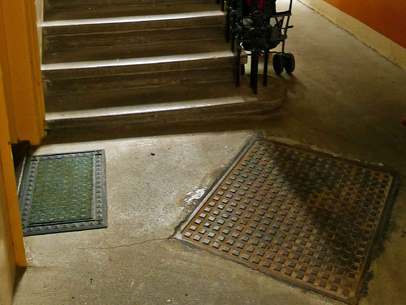Close/entrance floor
Heavily trafficked and likely to get worn, but a clean and well repaired close floor will make your building feel welcoming and safe.
Problems
Hollow sounding floors at ground level may indicate a void under the floor. This may have been caused by water from a leaking pipe washing away the soil. This can also affect the foundations of internal walls leading to subsidence.
Worn stone floor slabs or loose tiles may be trip hazards.
.jpg)
Solutions
Drains often run under the close floor. If you suspect a problem with the drains, then get a CCTV drain survey carried out to see if there are any cracks or breakages in the drainage system.

If the floor is built of stone slabs, these may need to be:
- re-laid
- replaced with concrete slabs
- screeded with granolithic concrete mix - this raises the height of the floor, so it may need to be applied to stairs and landings as well
- fully resurfaced with decorative composition flooring
It can be difficult to lift slabs without breaking them.
Loose tiles need to be lifted and re-laid with a suitable mortar adhesive. Victorian style encaustic tiles (often laid in geometric patterns) are still produced and some tiles can be matched. If a large section of the floor is damaged, then it may be best to renew the tiling.
Replacing composite flooring needs care as some older types contain asbestos.
Professional help recommended?
Although the work may appear straightforward, ensure your builder or tradespeople have the skills for the job. If in any doubt, get professional help to specify and organise the repair.
Further information